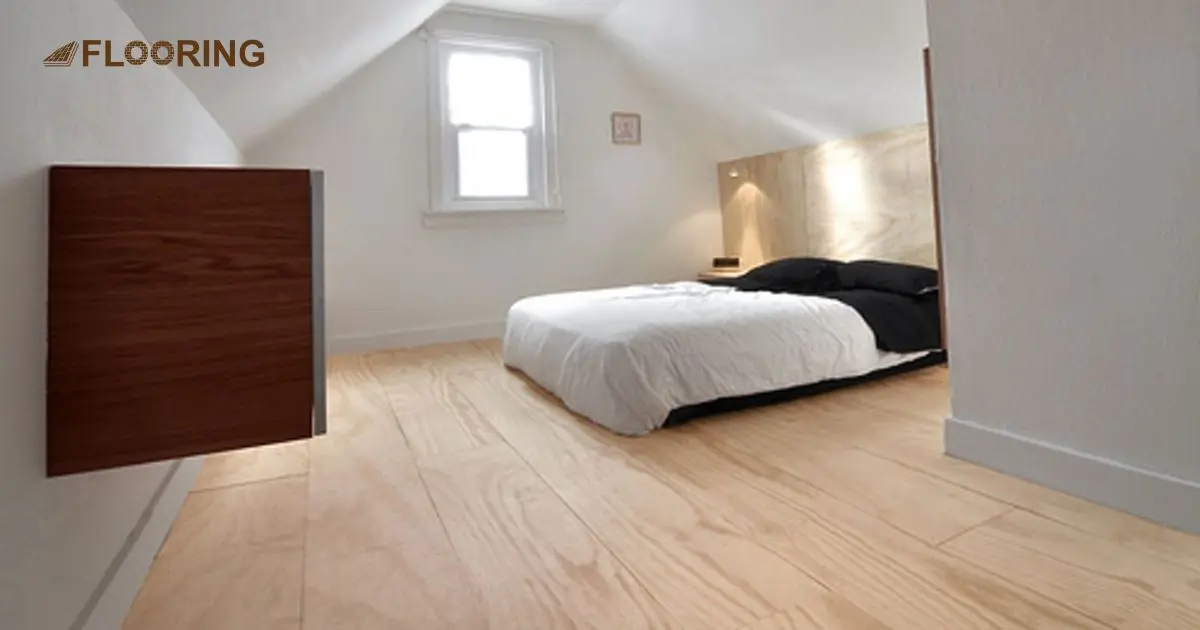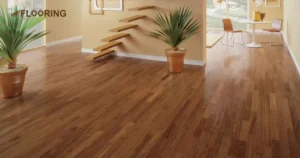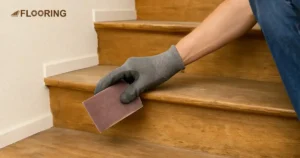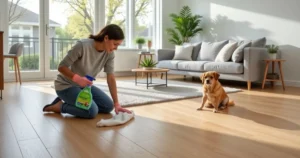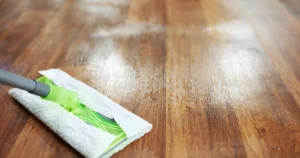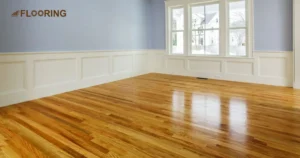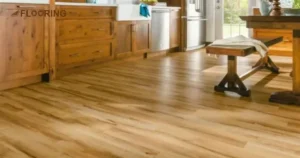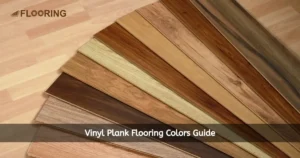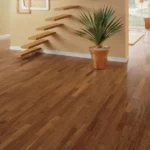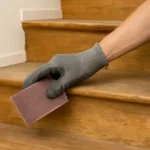Plywood flooring is an affordable, inexpensive, and versatile option for any home. Known for its durability and adaptability, you can customize it to fit various interior design styles. From living rooms to kitchens, plywood floor brings a nice addition to your home and provide a certain warmth and coolness in a certain sense.
Whether you’re looking for a modern touch or a rustic feel, plywood flooring can fulfill your needs. Find out plywood floor ideas that can refurbish your home within the limits of your budget. Imagine the possibilities that are ready to inspire you with these innovative designs of tomorrow.
So, it’s time to explore creative 10+ plywood floor transition ideas. We’ll be taking a look at different patterns and designs that can enhance any space.
📑 Table of Content
Key Takeaways
- Plywood is a versatile and cost-effective flooring option for homeowners.
- It can be customized with various finishes, including painting and staining.
- Proper installation techniques are crucial for ensuring the longevity of plywood flooring.
- Plywood offers good insulation and soundproofing when paired with underlayment.
- Regular maintenance and care can help preserve the appearance of plywood floors.
- Plywood flooring can be used in various settings, including residential and commercial spaces.
- Understanding the pros and cons of plywood flooring helps in making informed decisions.
- Plywood can be compared favorably to other flooring options like hardwood, laminate, and OSB.
What Is Plywood Flooring?

Plywood flooring is a smart choice for homeowners who want a durable and cost-effective option. It’s made from thin layers of wood veneer glued together to create strong sheets. These sheets come in various thicknesses and grades, giving you lots of options for your home.
The beauty of plywood lies in its versatility. You can leave it natural, paint it, or stain it to match your style. It’s also pretty easy to install, which makes it a hit with DIY fans. Plus, plywood can handle moisture better than some solid wood floors, making it a good pick for different rooms in your house.
One of the coolest things about plywood flooring is how it lets you get creative. You can cut it into planks, tiles, or even fun shapes to make unique patterns. This means you can create a floor that’s truly one-of-a-kind and fits your personality perfectly.
Benefits of Plywood Floor

- Plywood is generally less expensive than hardwood, making it a budget-friendly option.
- The multiple layers of veneer provide strength and stability, ensuring a long-lasting floor.
- Plywood can be finished in various ways to match different styles and preferences.
- Installing plywood flooring can be a DIY project, saving on professional installation costs.
- Plywood can be made from renewable resources and is often more environmentally friendly than other flooring options.
- Damaged sections of plywood flooring can be easily replaced or repaired without affecting the entire floor.
- Plywood offers a unique look with its natural wood grain and can be customized with stains, paints, and finishes.
- When properly sealed, plywood can resist moisture, making it suitable for kitchens and bathrooms.
- Plywood is lighter than other solid wood which makes it easier to handle and install.
- The layers of plywood provide better thermal insulation compared to some other flooring materials, contributing to energy efficiency in homes.
10+ Plywood Floors Ideas
Plywood floors offer endless possibilities for customization, allowing you to create unique and stunning designs in your home. Below are 10+ exciting ideas for plywood floors that can transform any space.
1. Natural Finish Plywood Floors

Natural finish plywood floors highlight the wood’s grain and texture, giving a rustic and organic feel to any room. This finish is perfect for those who appreciate the beauty of raw materials and want to bring a touch of nature indoors.
The natural look can complement various interior styles, from modern to traditional, making it a versatile choice.
2. Whitewashed Plywood Flooring

Whitewashed plywood flooring offers a fresh and airy look, ideal for creating a bright and open atmosphere. This finish involves applying a thin layer of white paint to the plywood, allowing the wood grain to show through.
These whitewashed floors are perfect for coastal, Scandinavian, or contemporary interiors, adding a light and clean aesthetic.
3. Geometric Pattern Plywood Floors

Geometric pattern plywood floors bring a bold and artistic touch to your home. By cutting and arranging plywood pieces into intricate designs, you can create visually stunning patterns that serve as a focal point in any room.
The patterns can range from simple shapes to complex motifs, offering endless design possibilities.
4. Stained Plywood Floor Ideas

Stained plywood floors provide a rich and vibrant look, enhancing the wood’s natural grain and color. Stains come in various shades, from light oak to deep mahogany, allowing you to customize the floor’s appearance to match your decor.
This finish adds depth and warmth to any space, making it a popular choice for living rooms and bedrooms.
5. Painted Plywood Floors Ideas

Painting plywood floors is an excellent way to add color and personality to your home. You can choose solid colors for a uniform look or get creative with patterns and designs.
Painted floors are perfect for kids’ rooms, play areas, or any space where you want to make a bold statement. These painting plywood floor ideas allow for endless customization to fit your style.
6. Distressed Plywood Floor Look

The distressed plywood floor look adds character and a vintage feel to your home. This finish involves intentionally aging the plywood to create a worn and rustic appearance.
It’s ideal for achieving a farmhouse or industrial style, bringing a sense of history and charm to any room. Distressed floors can be paired with modern or traditional decor for a unique contrast.
7. Herringbone Pattern Plywood Flooring

Herringbone pattern plywood flooring is a classic design that adds elegance and sophistication to any space. This pattern involves arranging plywood pieces in a zigzag layout, creating a dynamic and eye-catching look.
These floors are perfect for formal areas like dining rooms and entryways, making a statement with their intricate design.
8. Checkerboard Plywood Floor Design

Checkerboard plywood floor design offers a playful and nostalgic look, reminiscent of classic diners and vintage homes. By alternating light and dark plywood squares, you can create a striking checkerboard pattern that adds visual interest to any room.
This design works well in kitchens, bathrooms, and playrooms, adding a touch of fun and creativity.
9. Plywood and Concrete Combination Floors

Plywood and concrete combination floors bring a modern and industrial vibe to your home. By combining the warmth of plywood with the coolness of concrete, you can create a unique and balanced look.
A combination of plywood and concrete is perfect for lofts, studios, and contemporary spaces, offering a blend of textures and materials.
10. Epoxy-Coated Plywood Floors

Epoxy-coated plywood floors offer a sleek and durable finish, perfect for high-traffic areas. The epoxy coating provides a glossy and seamless surface, protecting the plywood from scratches and moisture.
This finish is ideal for garages, basements, and workshops, combining functionality with modern aesthetics.
11. Plywood Parquet Flooring

Plywood parquet flooring features small pieces of plywood arranged in intricate patterns, creating a luxurious and decorative look. Parquet designs can range from simple herringbone to elaborate mosaics, adding elegance and sophistication to any room.
Parquet plywood flooring is perfect for formal living areas and grand entrances.
12. DIY Plywood Floor Ideas

DIY plywood floor ideas allow you to customize your flooring to fit your personal style and needs. From painting and staining to creating unique patterns, the possibilities are endless.
These DIY projects can save money and provide a sense of accomplishment, making them a popular choice for homeowners looking to personalize their space.
13. Plywood Porch Floor Ideas

Plywood porch floor ideas focus on creating a welcoming and durable outdoor space. The plywood can be treated and finished to withstand the elements, making it a practical choice for porches and decks.
You can paint, stain, or seal the plywood to match your home’s exterior, creating a cohesive and inviting outdoor area.
Installing Plywood Floors
How to install plywood flooring is not a difficult process at all. Because installing these floors is a straightforward method that anyone can do with some basic tools and skills. Proper preparation and installation techniques are crucial to ensure a durable and attractive floor.
Preparing the Subfloor

Clean the subfloor – Ensure the subfloor is clean, dry, and free of debris before installing plywood floors.
Check for level – Verify the subfloor is level to prevent issues during installation.
Repair any damage – Fix any cracks or holes in the subfloor to create a smooth surface.
Remove old flooring – Take out any old flooring materials to start with a fresh base.
Install a moisture barrier – Lay down a moisture barrier to protect the plywood from dampness.
Acclimate the plywood – Let the plywood adjust to the room’s humidity and temperature for at least 48 hours.
Plan the layout – Measure and plan the layout to minimize cuts and waste.
Gather necessary tools – Ensure you have all the required tools and materials before starting.
Essential Tools for Installation

- Tape Measure
- Circular Saw
- Hammer And Nails
- Screws And Drill
- Moisture Barrier
- Flooring Adhesive
- Level
- Safety Gear
Step-by-Step Installation Guide

Follow these easy steps to install plywood flooring successfully:
Step 1 – Plan Your Layout
Measure the room and decide how you’ll arrange the plywood sheets. It’s best to stagger the joints for added stability.
Step 2 – Start in a Corner
Lay your first sheet of plywood, leaving a 1/8-inch gap around the edges for expansion.
Step 3 – Secure the Sheet
Use screws or nails to fasten the plywood to the subfloor, place fasteners every 6-8 inches around the edges and every 12 inches in the field.
Step 4 – Continue Laying Sheets
Work your way across the room, maintaining the expansion gap and staggering joints.
Step 5 – Cut to Fit
Use your circular saw or jigsaw to cut sheets as needed to fit around obstacles or in corners.
Step 6 – Check for Levelness
Use your level frequently to ensure the floor remains even as you work.
Step 7 – Fill and Sand
Once all sheets are in place, fill any screw holes or seams with wood filler. Sand the entire floor for a smooth finish.
Step 8 – Clean Up
Vacuum thoroughly to remove all dust and debris before applying your chosen finish.
Finishing Techniques for Plywood Floors

Finishing techniques can transform plywood floors from simple to stunning. Proper sanding, staining, and painting can enhance the beauty and durability of your floors.
Sanding and Sealing Plywood Floor
- Sanding and sealing are crucial steps in finishing plywood floors. Start by using a medium-grit sandpaper to sand the entire surface of the plywood. This step removes any rough spots and prepares the wood for sealing.
- After sanding, clean the floor thoroughly to remove any dust and debris then apply a wood sealant to protect the plywood from moisture and wear. Use a brush or roller to apply the sealant evenly, following the wood grain.
- Allow the sealant to dry completely before applying additional coats if necessary so that it can applied properly. Sealing the plywood not only enhances its durability but also brings out the natural beauty of the wood grain.
Staining Methods
- Staining plywood floors adds color and depth to the wood, enhancing its natural beauty. Choose a wood stain that complements your decor and apply it evenly with a brush or cloth. Work in small sections to ensure even coverage and follow the wood grain for the best results.
- Allow the stain to penetrate the wood for the recommended time before wiping off any excess with a clean cloth. For a deeper color, apply additional coats of stain, allowing each coat to dry completely before applying the next.
- Once the desired color is achieved, seal the stained floor with a clear sealant to protect it from wear and moisture.
Painting Techniques
- Ideas for painting plywood floors are a versatile and creative way to customize your space. Begin by sanding the plywood to create a smooth surface for the paint, apply a primer to ensure the paint adheres properly to the wood.
- Once the primer is dry, choose a high-quality floor paint and apply it in thin, even coats. Use a brush for edges and corners and a roller for larger areas so that you can create solid colors, patterns, or even stencils for a unique look.
- Allow each coat to dry completely before applying the next and finish with a clear topcoat to protect the painted surface from scratches and wear.
Maintaining Plywood Floors

Maintaining plywood floors ensures they remain beautiful and durable for years. Regular cleaning and proper care can prevent damage and keep your floors looking their best.
Daily Cleaning Tips
Daily cleaning is essential for maintaining plywood floors.
- Start by sweeping or vacuuming the floor to remove dust, dirt, and debris.
- Use a soft-bristled broom or a vacuum cleaner with a hardwood floor attachment to avoid scratching the surface while cleaning the plywood floor.
- For more thorough cleaning, use a damp mop with a mild floor cleaner specifically designed for wood floors.
- Avoid using excessive water, as it can damage the plywood, and wipe up spills immediately to prevent stains and water damage.
Regular daily cleaning helps keep your plywood floors looking fresh and extends their lifespan.
Long-Term Maintenance Strategies for Plywood Floor
Long-term maintenance of plywood floors involves periodic deep cleaning and preventive measures.
- Every few months, give your floors a deep clean using a wood floor cleaner and a microfiber mop.
- Consider applying a new coat of sealant or finish every couple of years to protect the wood and enhance its appearance.
- Use furniture pads under heavy pieces to prevent scratches and dents, you can also place rugs or mats in high-traffic areas to reduce wear and tear.
- Avoid dragging furniture or heavy objects across the floor to prevent damage.
By following these strategies, you can maintain the beauty and integrity of your plywood floors for years.
Dealing with Scratches and Dents on Plywood Floor
Scratches and dents are common issues with plywood floors, but they can be addressed with proper care.
- For minor scratches, use a wood touch-up marker that matches the color of your floor. Gently fill in the scratch and blend the color with a soft cloth.
- For deeper scratches, sand the area lightly with fine-grit sandpaper and apply a matching wood stain or finish.
- Dents can be minimized by placing a damp cloth over the dent and applying heat with an iron.
- The steam helps the wood fibers expand, reducing the appearance of the dent.
Regularly inspect your floors and address any damage promptly to keep them looking their best.
Comparing Plywood Flooring with Other Options
Comparing plywood flooring with other flooring options helps you make an informed decision about what best suits your needs. Each type of flooring whether hardwood, laminate, vinyl, or plywood has its unique advantages and disadvantages.
Hardwood vs Plywood

| Feature | Hardwood Flooring | Plywood Flooring |
| Cost | Generally more expensive | More affordable |
| Durability | Extremely durable, can last decades | Durable, but slightly less than hardwood |
| Aesthetic Appeal | Natural and luxurious look | Versatile, can mimic various styles |
| Installation | Often requires professional installation | Can be a DIY project |
| Maintenance | Needs regular maintenance and refinishing | Easier to maintain |
| Environmental Impact | Often less sustainable | Can be made from renewable resources |
| Moisture Resistance | Can warp with moisture exposure | More moisture-resistant when sealed |
| Repairability | Easier to repair individual planks | Repairs can be more challenging |
| Versatility | Limited to natural wood variations | Can be painted, stained, or sealed |
| Weight | Heavier, more difficult to handle | Lighter, easier to install |
Laminate vs Plywood Floor

| Feature | Laminate Flooring | Plywood Flooring |
| Cost | Generally affordable | Similar, but can vary |
| Durability | Resistant to scratches and dents | Durable, but less resistant |
| Aesthetic Appeal | Mimics various materials | Natural wood look or customizable |
| Installation | Easy click-lock installation | Requires nails or screws |
| Maintenance | Easy to clean and maintain | Requires more care |
| Environmental Impact | Often less eco-friendly | Can be made from renewable resources |
| Moisture Resistance | Good moisture resistance | Needs proper sealing |
| Repairability | Damaged planks need replacement | Can be repaired or patched |
| Versatility | Limited to pre-designed styles | Highly customizable |
| Comfort | Softer underfoot with padding | Firmer feel |
Vinyl vs Plywood

| Feature | Vinyl Flooring | Plywood Flooring |
| Cost | Generally affordable | Similar, but can vary |
| Durability | Highly durable, water-resistant | Durable, needs sealing for moisture |
| Aesthetic Appeal | Wide range of styles and colors | Natural look, customizable |
| Installation | Easy to install | Requires more effort |
| Maintenance | Easy to clean | Requires more care |
| Environmental Impact | Often less eco-friendly | Can be more sustainable |
| Moisture Resistance | Excellent moisture resistance | Needs proper sealing |
| Repairability | Difficult to repair, often replaced | Can be repaired or patched |
| Versatility | Limited to pre-designed styles | Highly customizable |
| Comfort | Softer underfoot | Firmer feel |
Pros and Cons of Plywood Flooring

Plywood flooring is a popular choice for many homeowners due to its affordability and versatility. However, it has both advantages and potential drawbacks that you should consider before making a decision.
Advantages of Plywood Floors
Plywood floors offer many benefits, here are some of the main advantages:
Cost-Effective: Plywood is more affordable than many other flooring options.
Versatile Appearance: Plywood can be stained, painted, or left natural for different looks.
Easy Installation: DIY enthusiasts can install plywood floors with basic tools and skills.
Durable: Plywood floors can withstand regular foot traffic and daily use.
Moisture Resistant: When sealed properly, plywood can resist moisture better than some wood types.
Sustainable Option: Plywood is often made from renewable resources, making it eco-friendly.
Customizable: You can easily cut plywood to fit any room shape or size.
Lightweight: Plywood is easier to handle and transport compared to other materials.
Potential Drawbacks of Plywood Floor to Consider
While plywood floors have many advantages, there are some drawbacks to consider:
Susceptible To Water Damage: Without proper sealing, plywood can warp or swell when exposed to moisture.
Requires Regular Maintenance: Plywood floors need regular cleaning and sealing to maintain their appearance.
Less Luxurious: Plywood might not have the same luxurious look as hardwood floors.
Limited Longevity: Plywood floors may not last as long as more durable flooring materials.
Can Scratch Easily: Plywood is prone to scratches and dents from heavy furniture or sharp objects.
Needs Protective Finishes: To enhance durability, plywood requires protective finishes like sealant or paint.
May Emit VOCs: Some plywood contains volatile organic compounds (VOCs) that can affect indoor air quality.
Surface Irregularities: Plywood may have knots and grain patterns that some might find less appealing.
Frequently Asked Questions
Can I use plywood as flooring?
Yes, you can use plywood as flooring. It’s a cost-effective and versatile option that can be stained, painted, or sealed to achieve various looks. Plywood flooring is durable when properly installed and finished.
What are the disadvantages of plywood flooring?
Plywood flooring can be sensitive to moisture if not properly sealed, which may lead to warping or damage. It may also have a lower resale value compared to traditional hardwood floors and can only be refinished a limited number of times.
What is the best plywood for flooring?
The best plywood for flooring is typically marine-grade or exterior-grade plywood with at least five plies. These types are more resistant to moisture and provide a stable, durable surface for flooring applications.
Is plywood or OSB better for flooring?
Both plywood and OSB (Oriented Strand Board) can be used for flooring, each with its own advantages. Plywood is generally stronger and more water-resistant, while OSB is often cheaper but the choice depends on your specific needs and budget.
Do you need underlayment on plywood floor?
In most cases, you don’t need underlayment on a plywood floor if it’s installed over a proper subfloor. However, using underlayment can provide extra insulation, sound dampening, and moisture protection. It’s especially useful in basements or areas prone to dampness.
What depth should plywood be for flooring?
For flooring, plywood should be at least 3/4 inch thick. This thickness provides adequate strength and stability for most residential applications. Thicker plywood may be needed for commercial spaces or areas with heavy traffic.
Can I use regular plywood for subfloor?
Regular plywood isn’t ideal for subflooring. It’s better to use tongue-and-groove plywood specifically designed for subflooring, such as OSB or exterior-grade plywood. These options provide better stability and moisture resistance.
How many layers of plywood for a subfloor?
Typically, one layer of 3/4-inch tongue-and-groove plywood is sufficient for a subfloor. However, in some cases, two layers might be used for added stability. The number of layers depends on the joist spacing and local building codes.
What goes between plywood and flooring?
Between plywood and flooring, you might use underlayment, a moisture barrier, or both. Underlayment provides a smooth surface and can improve sound insulation. A moisture barrier protects the flooring from any dampness in the subfloor.
Should you leave a gap between plywood flooring?
Yes, you should leave a small gap between plywood flooring sheets. A 1/8-inch gap allows for natural expansion and contraction of the wood due to temperature and humidity changes. This gap helps prevent buckling or warping of the floor.
Conclusion
Plywood flooring offers a wide range of creative possibilities, making it an excellent choice for easy installation. With various ideas for plywood floors, you can create unique and stylish spaces that reflect your personal taste. From painted plywood floor ideas to natural finishes, plywood is versatile and budget-friendly.
Incorporating plywood floors in your home can transform any room, adding warmth and character. Whether you’re looking for diy plywood floor ideas or professional installations, the options are vast and varied. Plywood’s adaptability means you can customize your flooring to match your vision, making it a practical and aesthetic choice.
Plywood can complement other design elements in your home, such as a wood fence, creating a cohesive and harmonious look. By exploring different plywood porch floor ideas, you can enhance both interior and exterior spaces, adding value and charm to your property.
